
Marketing
Why are reviews important for your retail store?
Reviews guide customers as they make choices, foster trust, and can even give sales a significant lift. If your clothing...
Facebook vs. Instagram Ads: Which Ones Take the Lead in Paid Advertising?
Marketing
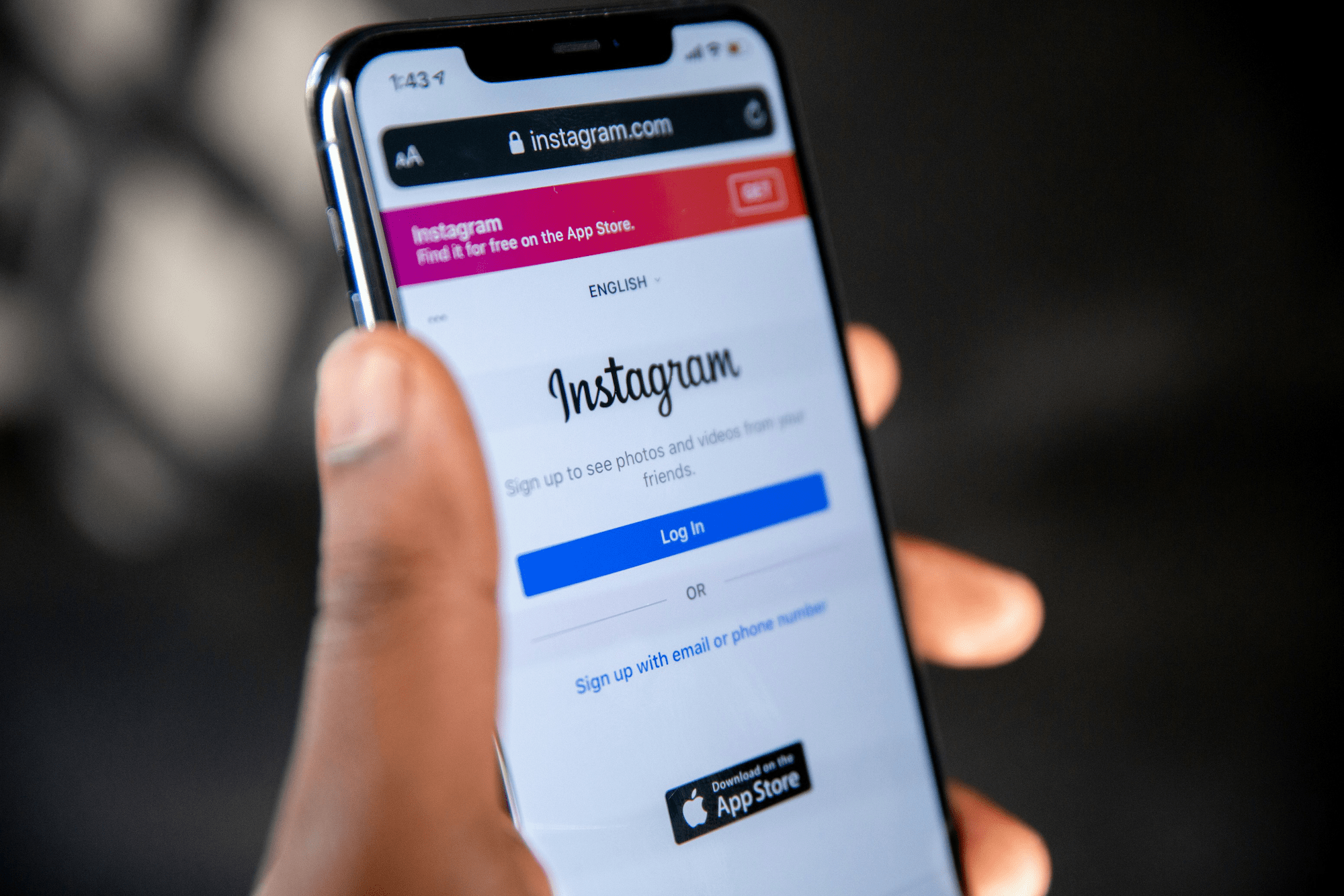
In paid advertising, where every click and view can turn into a potential sale, choosing the right platform for your ads can feel like a tough choice.
Within the blink of an eye, Facebook and Instagram have evolved from simple social media apps used to communicate with acquaintances and share personal moments to powerful marketing tools used to promote businesses and earn big profits.
For years now, both have been keeping a steady position in the top 5 most popular social networks (Statista), serving millions of users daily and providing marketers with access to diverse demographics.
But here's the million-dollar question: between Facebook, with its vast user base and detailed targeting options, and Instagram, known for its high engagement rates and visually appealing content, which one leads the charge in paid advertising?
In this Facebook vs. Instagram ads comparison we unpack everything - from targeting audiences to ad formats.
Facebook ads are a powerful tool for businesses looking to reach a vast audience through the social media giant Facebook.
These ads appear in several locations on the platform, including:
Advertisers on Facebook can target users based on demographics, interests, and behaviors and can create Custom Audiences, whereas dropshipping stores can retarget website visitors or use contact lists, and Lookalike Audiences, to reach new people who are similar to existing customers.
This versatility makes Facebook an attractive option for advertisers looking to create highly personalized ad experiences.
Check out: Facebook vs. Google Ads
Coltori’s ad takes full advantage of the power of collection ads, displaying multiple products in their ad.
Each product featured in the ad has its own image, description, and CTA button, providing more information directly within the ad.
By clicking on a product, users are taken directly to Coltorti’s product pages, where they can proceed to make a purchase.
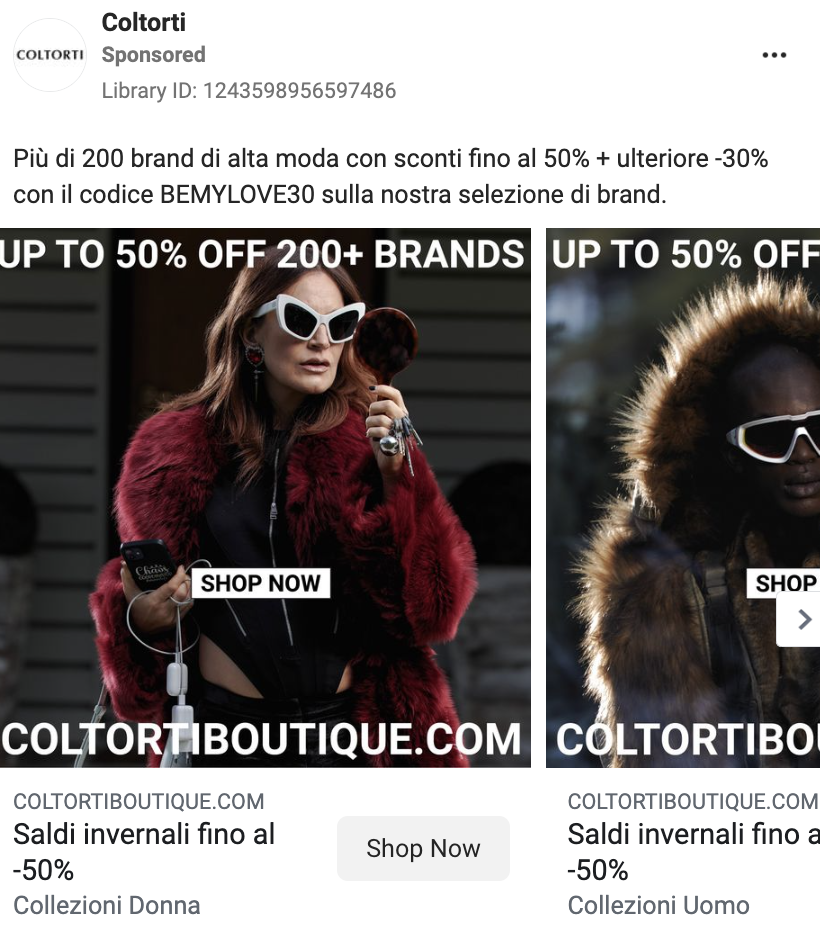
The secret of the success of Moda Operandi’s image ads lies in their simplicity.
With a stunning image, simple description, and convenient CTA that leads viewers to their shopping pages, the Moda Operandi ad seizes the store’s customers’ attention and stimulates great interest in their brand and products.
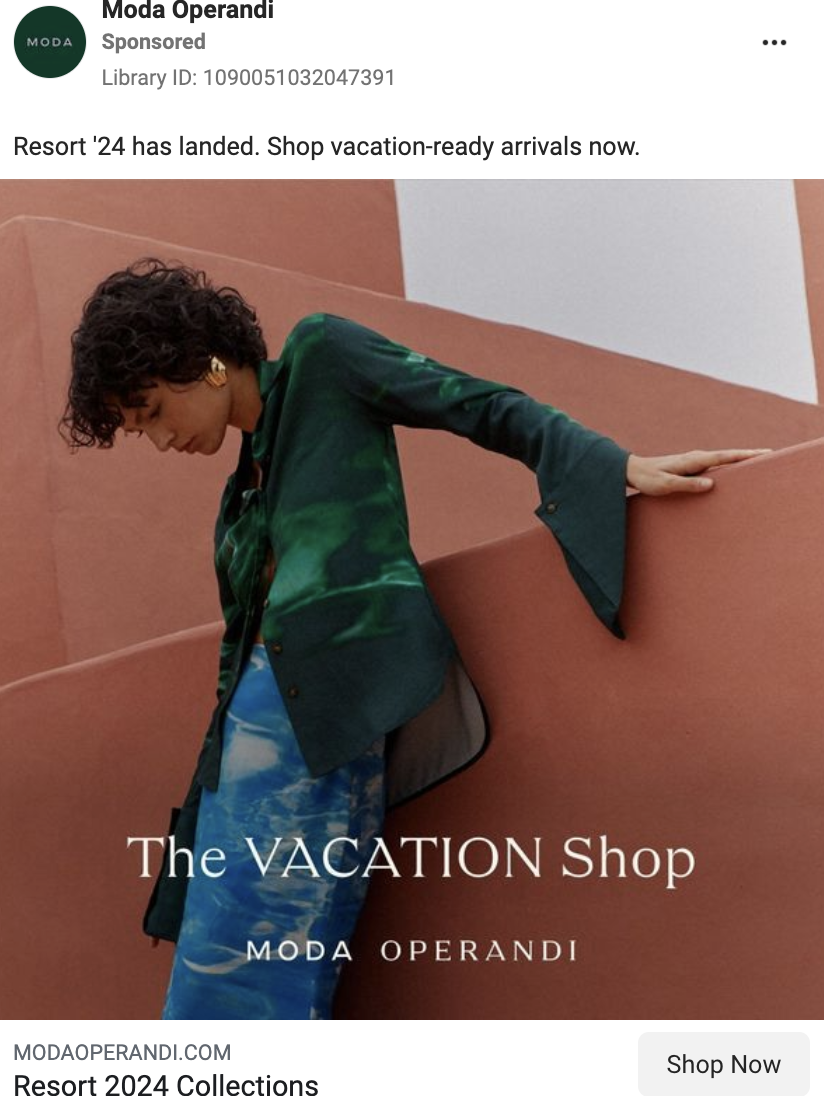
YOOX’s video ads allow the brand to not only advertise its products but also to share the brand’s narrative through visual storytelling.
Their ad quickly communicates the key message and incites immediate action.
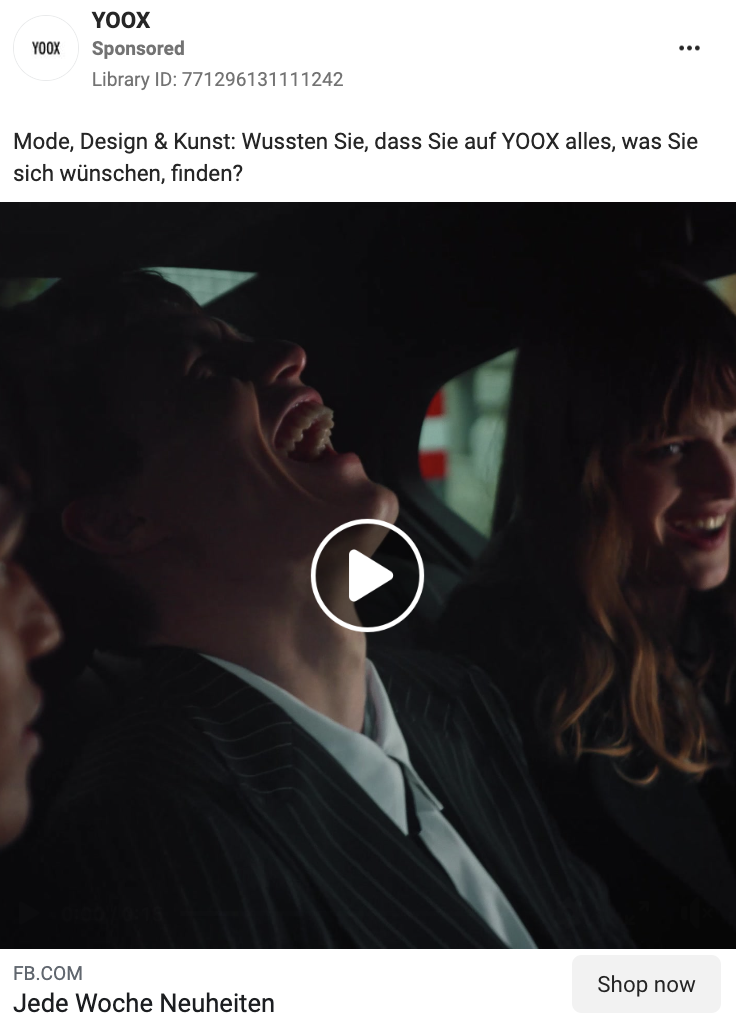
Instagram ads are the ads found on the social media platform Instagram.
These can pop up across Instagram in users’ News feeds, Stories, and Explore tab, as well as throughout Facebook, Messenger, and Audience Network.
Dropshipping businesses can create Instagram ads through Facebook’s advertising tools (Meta Business Suite) due to the platforms being interconnected. This allows for detailed targeting and analytics similar to Facebook’s ad system.
Instagram is the go-to platform for brands that want to create visually captivating campaigns that drive user engagement and sales.
Ad objectives cover a wide range of goals such as brand awareness, lead generation, traffic redirection to websites or apps, and conversions, allowing you to target different goals with different ad campaigns.
Because of Alice adopts a simple yet captivating ad campaign by running video ads.
They stick to a minimalist aesthetic in their video and a straightforward brand message.
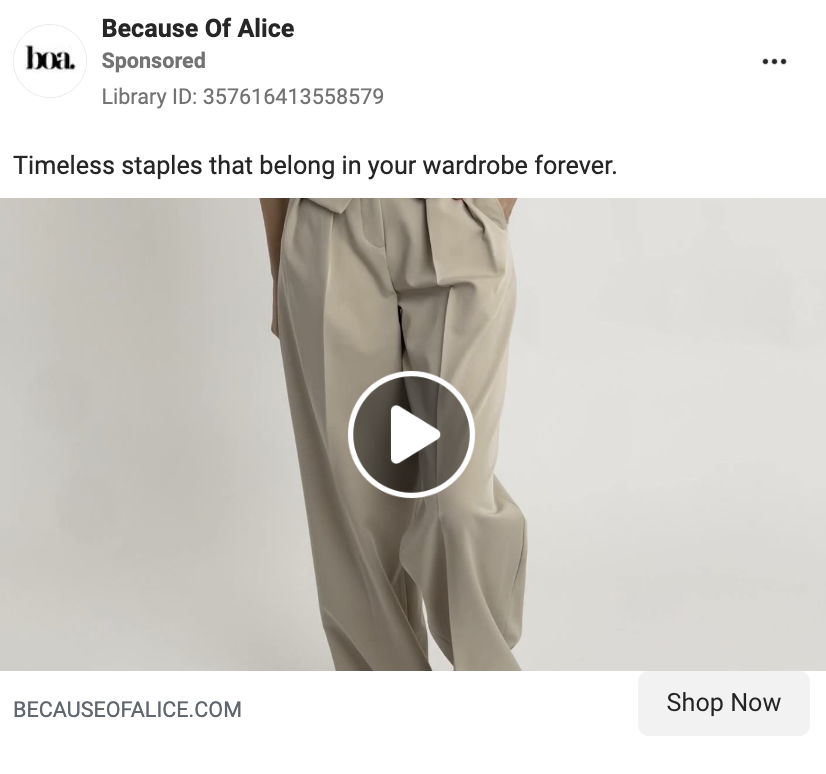
Alohas uses Instagram stories as one of their ad formats.
The ad intriguingly hides part of its message, enticing viewers to click the ‘More’ button for full details.
Starting with ‘Last chance’ in bold letters, the ad signals the importance of the announcement, urging viewers to pay attention.
By offering a discount that expires in 48 hours, it prompts customers to act swiftly to take advantage of the offer or risk missing out.
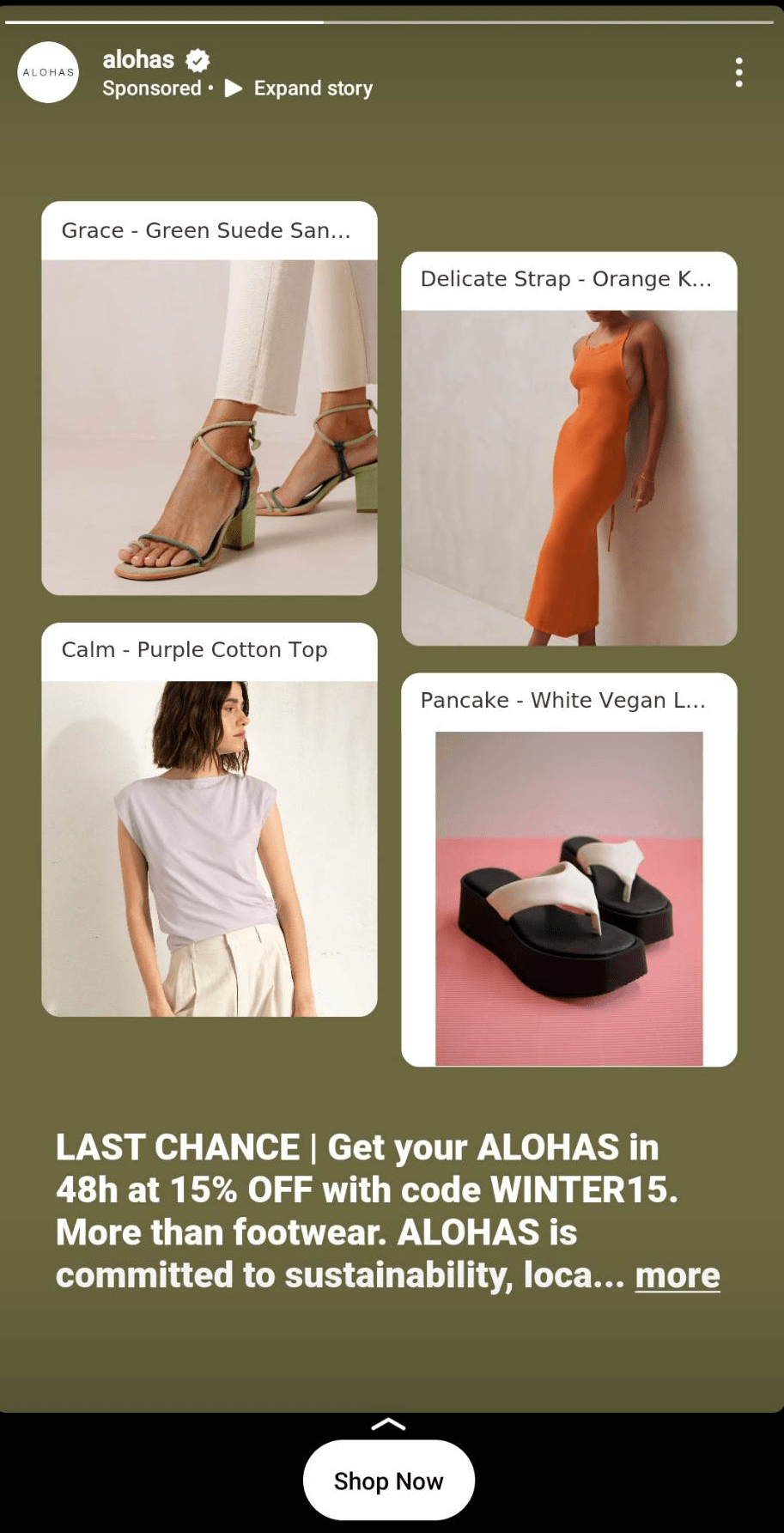
SSENSE excels with their shopping ad by leveraging the popular ‘whomst’ meme.
The brand skillfully highlights its diverse sunglasses range, from minimalist to boundary-pushing designs, and uses a short and impactful tagline to ensure the message is communicated efficiently, understanding that customers often skip over lengthy descriptions.
Check out: How to create Google shopping ads?
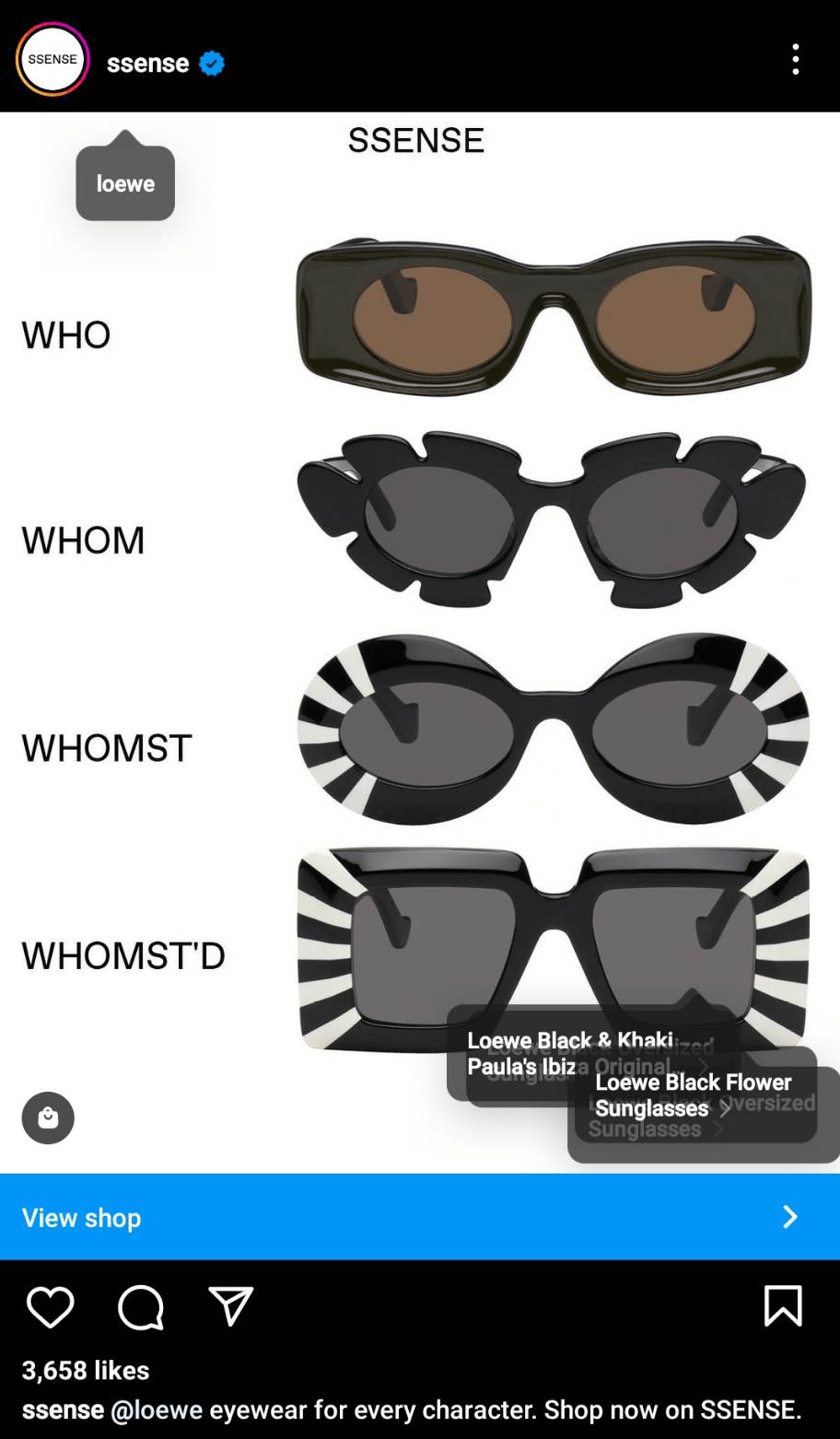
Running Facebook ads isn’t complicated, and there’s no need to get lost in the process. Let’s take a step-by-step look at how you can create your own ad campaigns on Facebook.
Creating Instagram ads takes almost the exact same process as running Facebook ads as both types of ads are managed through the Meta Business Suite:
Managing an advertising budget is crucial for any dropshipping business, big or small.
Understanding the costs associated with Facebook and Instagram can help you make informed decisions about where to invest your money.
As Facebook and Instagram are both owned now by Meta, their advertising platforms are interconnected. However, their ad costs are still quite different.
According to AdRoll, the Facebook CPC rates can start at around $0.44 while the Facebook CPM metric charges an average of $14.40.
On the other hand, the Instagram CPC rates range between $0.02 and $2.00 while the CPM rates cost an average of $6.70.
Check out: Most important Facebook ad metrics
Both Facebook and Instagram ads are available in the same ad formats, which are quite a few, allowing you to experiment with various content types.
This is a big advantage of both platforms because it lets you connect with your target audience in more ways than one.
| Ad Type | Description |
|---|---|
| Single image ads | Traditional and simple, yet effective. It’s all about packing a punch with one powerful image. |
| Video ads | Trendy and engaging, they can convey your message effectively. |
| Carousel ads | Present up to 10 images or videos within a single ad, each having its own link. |
| Collection ads | Mobile-only ads displaying multiple products from your catalog. |
| Slideshow ads | A light video-like ad made from text, images, or existing video clips. |
| Stories ads | Full-screen vertical ads that appear between stories. |
| Shopping ads | Allows users to purchase directly from the ad without leaving the app, offering a unique way to promote and sell fashion products. |
| Explore ads | Available on Instagram, located in the Explore section, emerging after engaging with a photo or video. |
Check out: Best Instagram ads examples
When it comes to reach, both Facebook and Instagram have masses of users worldwide that you can tap into. However, they offer different potentials depending on your target audience.
Facebook‘s expansive user base encompasses a diverse age range, from teenagers to seniors, providing a fertile ground for advertisers aiming to reach a broad audience spectrum.
Whether you’re marketing products suited for the youth or services targeted at older demographics, Facebook’s varied audience demographics offer the flexibility to tailor your advertising campaigns to specific age groups, interests, and behaviors.
This wide-reaching demographic inclusivity makes Facebook a versatile platform for dropshipping businesses aiming to cast a wide net or target niche markets within different age groups.
Check out: Best inbound marketing examples
Instagram resonates much stronger with a younger audience, predominantly those under 35, more specifically, Gen Zers as well as millennials.
This makes it a prime choice for brands looking to build a dynamic and engaging presence among these age group populations.
For dropshippers focused on tapping into the vibrant, trend-conscious, and younger market segments, Instagram provides an optimal environment.
Pros:
Cons:
Pros:
Cons:
When it comes down to the final verdict on Facebook vs. Instagram ads, the truth is, there’s no clear winner.
Your decision on which one to choose shouldn’t come down to which one is better, but which one aligns more closely with your dropshipping store’s marketing objectives.
By using them together, you can create a multi-faceted advertising strategy that captures the attention of your audience, wherever they choose to scroll.
At the end of the day, successful advertising demands trial and error. Don’t be afraid of tweaking your strategy and go back and forward between these two platforms.
Sometimes, what works best is what you least expected!
Deciding whether to advertise on Instagram or Facebook depends on your target audience and the type of content you plan to share. Instagram is great for visually appealing products and a much younger demographic, such as Gen-Zs, while Facebook offers a broader audience reach where you can target different age demographics.
Yes, Instagram ads typically cost more than Facebook ads. This is because Instagram generally has higher engagement rates, which can lead to a higher cost per click (CPC) or cost per impression (CPM) on the platform compared to Facebook. However, the exact cost can vary widely depending on factors like your target audience, the competitiveness of your industry, and the time of year.
Yes, they are. With 3 billion monthly active users, Facebook gives you access to a vast audience. The platform’s detailed targeting options mean you efficiently can zero in on your ideal customers.
Yes, they are. With over 1.6 billion active users, Instagram is a great paid advertising option if you’re targeting a younger demographic or your brand focuses on creating visually appealing content.
What is dropshipping?